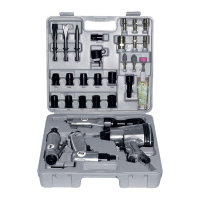1F–54 ENGINE CONTROLS
DAEWOO M-150 BL2
FUEL INJECTOR BALANCE TEST
A fuel injector tester is used to energize the injector for a
precise amount of time, thus spraying a measured
amount of fuel into the intake manifold. This causes a
drop in the fuel rail pressure that can be recorded and
used to compare each of the fuel injectors. All of the fuel
injectors should have the same pressure drop.
Fuel Injector Balance Test Example
Cylinder 1 2 3
First Reading 380 kPa
(55 psi)
380 kPa
(55 psi)
380 kPa
(55 psi)
Second Reading 215 kPa
(31 psi)
201 kPa
(29 psi)
230 kPa
(33 psi)
Amount Of Drop 165 kPa
(24 psi)
179 kPa
(26 psi)
151 kPa
(22 psi)
Average Range: 156-176 kPa
(22.5-25.5 psi)
Injector OK Faulty Injector –
Too Much
Pressure Drop
Faulty Injector –
Too Little
Pressure Drop
Caution: The fuel system is under pressure. To
avoid fuel spillage and the risk of personal injury or
fire, it is necessary to relieve the fuel system pres-
sure before disconnecting the fuel lines.
Caution: Do not pinch or restrict fuel lines. Damage
to the lines could cause a fuel leak, resulting in pos-
sible fire or personal injury.
Notice: In order to prevent flooding of the engine, do not
perform the Injector Balance Test more than once (in-
cluding any retest on faulty fuel injectors) without run-
ning the engine.
Test
Notice: An engine cool down period of 10 minutes is
necessary in order to avoid irregular readings due to hot
soak fuel boiling.
1. Connect the fuel pressure gauge carefully to avoid
any fuel spillage.
2. The fuel pump should run about 2 seconds after the
ignition is turned to the ON position.
3. Insert a clear tube attached to the vent valve of the
fuel pressure gauge into a suitable container.
4. Bleed the air from the fuel pressure gauge and hose
until all of the air is bled from the fuel pressure gauge.
5. The ignition switch must be in the OFF position at
least 10 seconds in order to complete the electronic
control module (ECM) shutdown cycle.
6. Turn the ignition ON in order to get the fuel pressure
to its maximum level.
7. Allow the fuel pressure to stabilize and then record
this initial pressure reading. Wait until there is no
movement of the needle on the fuel pressure gauge.
8. Follow the manufacturer’s instructions for the use of
the adapter harness. Energize the fuel injector test-
er once and note the fuel pressure drop at its lowest
point. Record this second reading. Subtract it from
the first reading to determine the amount of the fuel
pressure drop.
9. Disconnect the fuel injector tester from the fuel in-
jector.
10. After turning the ignition ON, in order to obtain maxi-
mum pressure once again, make a connection at
the next fuel injector. Energize the fuel injector test-
er and record the fuel pressure reading. Repeat this
procedure for all the injectors.
11. Retest any of the fuel injectors that the pressure
drop exceeds the 10 kPa (1.5 psi) specification.
12. Replace any of the fuel injectors that fail the retest.
13. If the pressure drop of all of the fuel injectors is with-
in 10 kPa (1.5 psi), then the fuel injectors are flowing
normally and no replacement should be necessary.
14. Reconnect the fuel injector harness and review the
symptom diagnostic tables.

